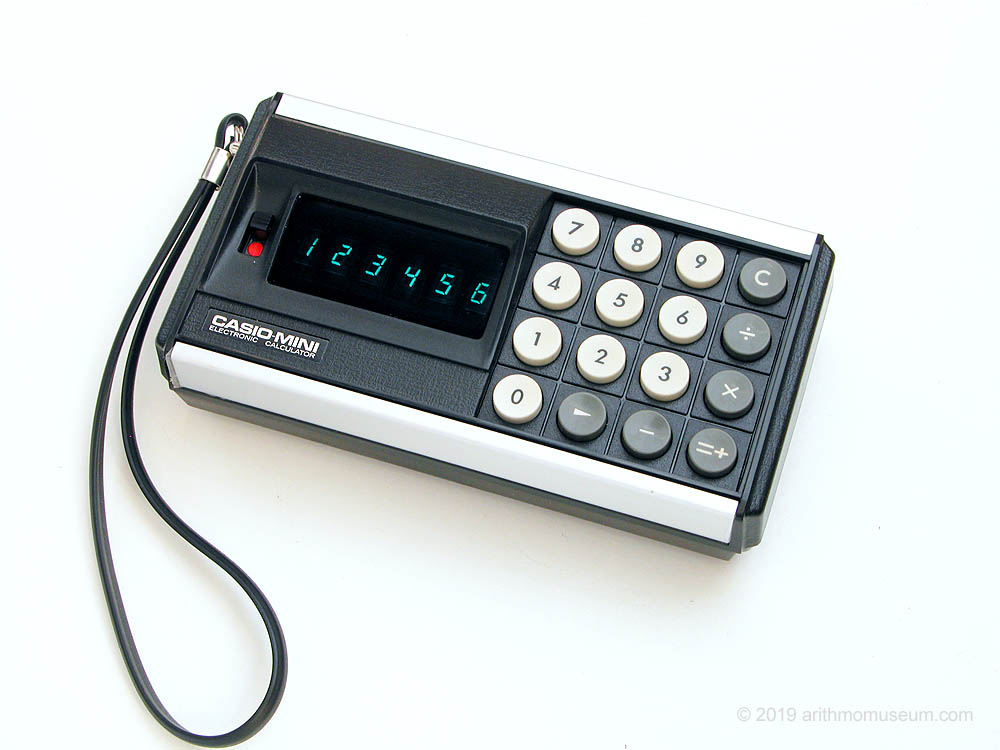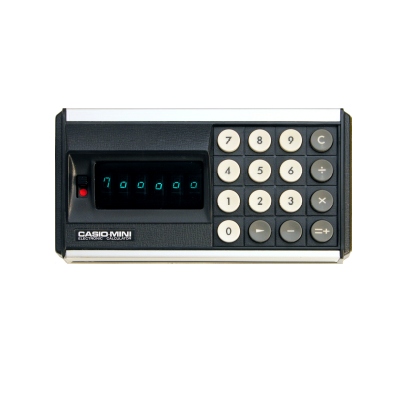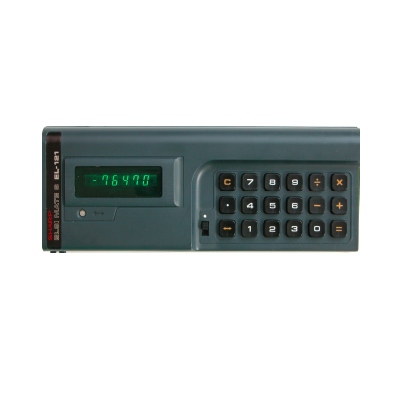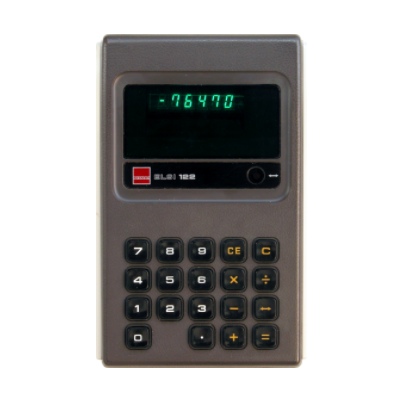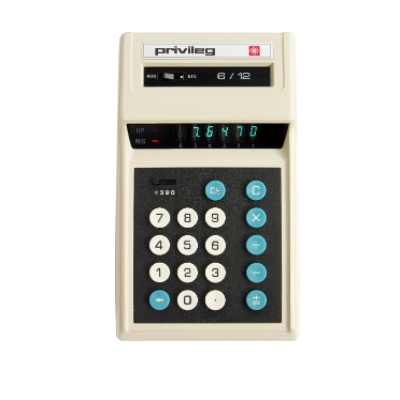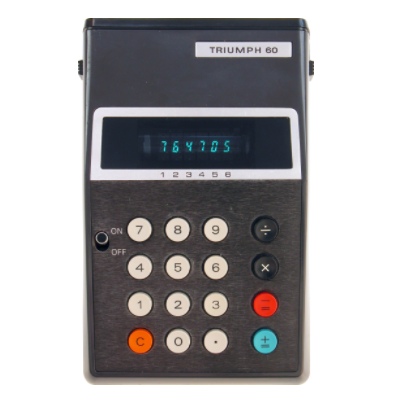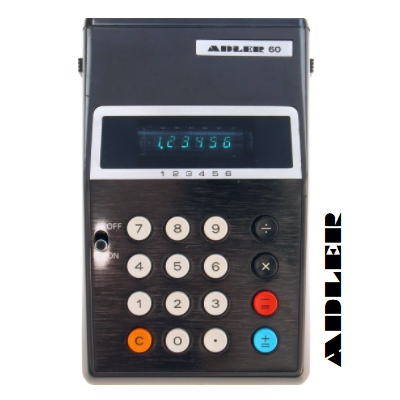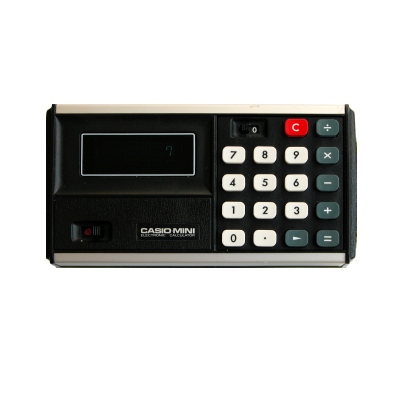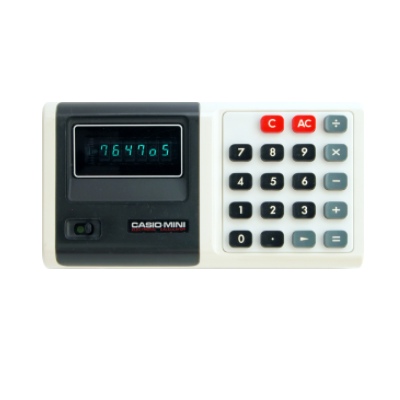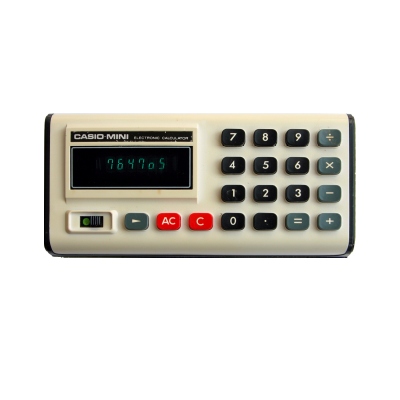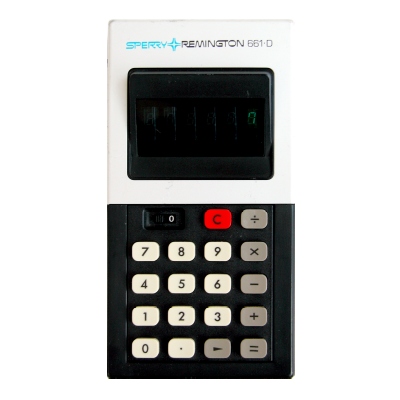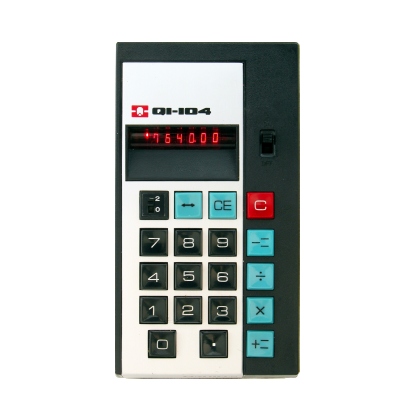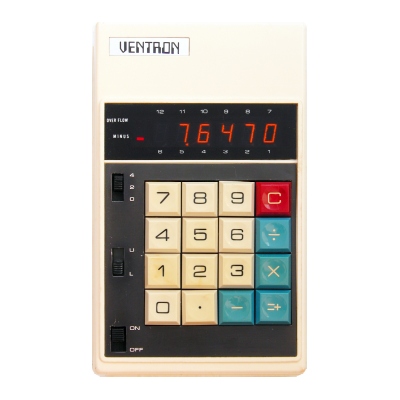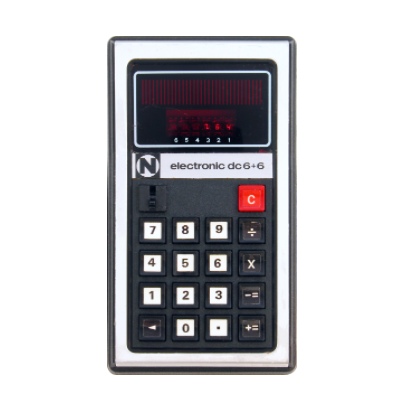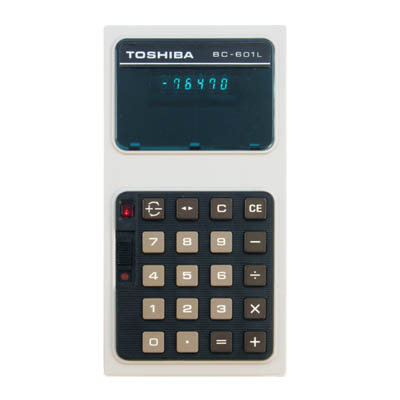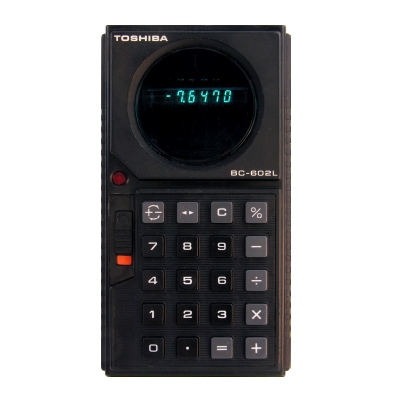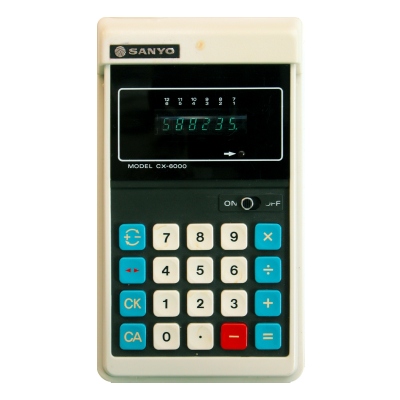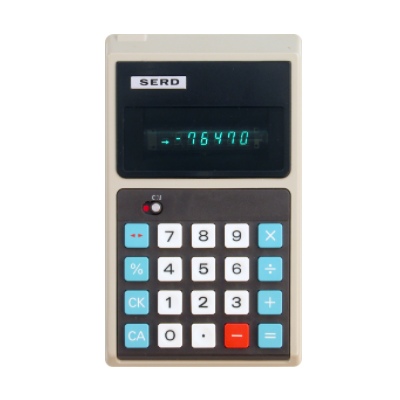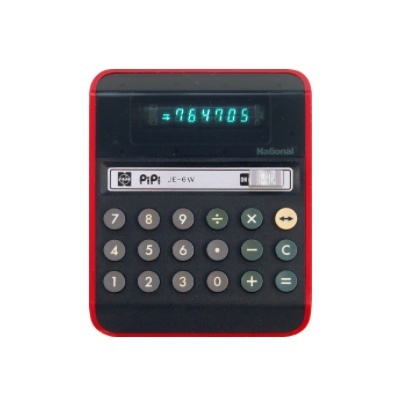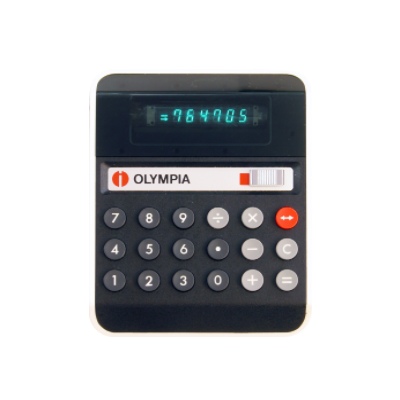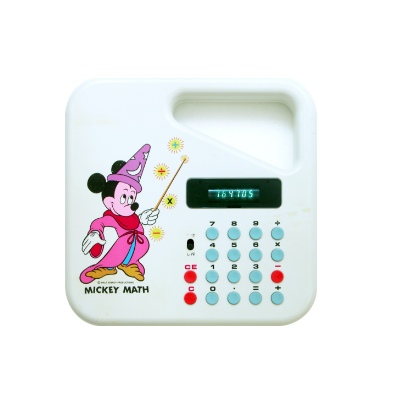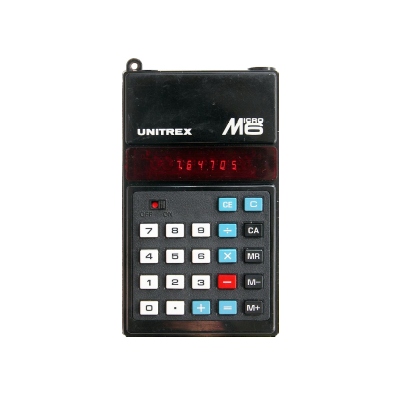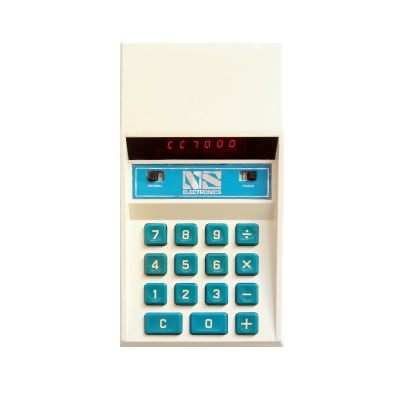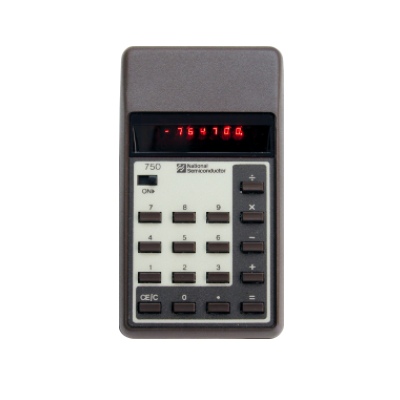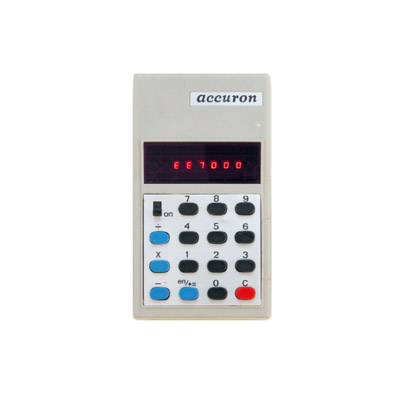Milestones in the History of Calculators
Six-digit calculators
The price of the machines was still very high, but it was clear to almost every manufacturer that if they managed to reach a price level that would allow the calculators to become a real mass product, a very nice profit could be made due to the large quantities.
The reduction in manufacturing costs was not least achieved by reducing the size of the display, especially considering that each digit in the calculators of the era required a separate display tube, but the cost savings from reducing the number of digits in LED displays were also not negligible.
The high-reliability, popular Reed-relay keyboards did not meet the requirements: it consumes large size and must be soldered manually. In this way, the designers tried to create keyboards with the simplest possible structure. There was manufactured a machine without keyboard, where you could enter numbers and perform operations by touching the metal contacts with a pen-like device.
The simpler the structure of a circuit, the simpler and faster it is to design and manufacture. Thus, the designers created the simplest possible versions of the “programs” that performed the calculations for these “household” calculators.
If the machines can be operated with batteries, there is no need for a built-in transformer, which has resulted in lighter devices from now on. For possible mains operation, most companies have also made optional mains adapters so that you do not have to change batteries constantly.
The displays of the calculators based on the principles mentioned above had capacity of 3 to 6 digits, their internal calculation precision was 6 to 12 digits, initially comes with arithmetic logic, but from 1974 onwards with easier-to-use algebraic logic, and over time more and more additional functions were added, so they calculated percentages and roots or even had a memory register. As they did not have a proven working principle, most of them have different operations and uses, some of them have very strange features. In this article, we will only list machines built with six-digit displays, because this way they can be easily compared with each other — like in a hardware test. We will return to machines with a capacity of less than six digits — these made in only a few versions — later.
Alapvetően a hatdigites típusoknak kétféle változata van. Közös jellemzőjük, hogy hat számjegy megjelenítésére alkalmas kijelzőjük van. Az első típus valóban csak hat számjegyre pontosan képes műveleteket végezni — esetleg a szorzást elvégzik 12 jegyre is, de ezt az eredményt csak megnézni lehet, számolni vele már nem —, a második típus viszont úgy működik, mint egy szokványos 12 digites számológép, annyi különbséggel, hogy kijelzőjén egyszerre csak 6 számjegy fér el. Így a gép vagy az első, vagy a második hat számjegynyi „ablakot” tudja megjeleníteni.
Vegyük sorra a hatszámjegyes típusokat, kialakulásuk sorrendjében:
There are basically two main types of six-digit calculators. What they have in common is that they have a six-digit display. The first type can only perform operations with exactly six digits — possibly multiplying to 12 digits, but this result can only be seen, not can be used for further calculations — while the second type works like a standard 12-digit calculator, with only difference that the display can show the first or second 6-digit part of the result.
Let’s see these calculators in historical order.
Unisonic MINI
Sperry 661
Japanese Casio makes the cheapest calculator for everyone
In 1972, Casio, which has extensive experience in the manufacture of desktop calculators, set out to design a calculator that was cheaper and smaller than ever before. At first, a four-digit capacity was considered, and the handling of decimals was discarded, so this machine would have been capable of performing the scoring tasks of bowling games, as the company’s young employees had dreamed of during such this game. This was later changed to six digits. The Casio Mini was released in August 1972 and has been incredibly successful, thanks to its really low price — 12,800 yen — and to nationwide ads and TV commercials. At the time of its release, the pocket calculators of competing companies ranged in price from 30,000 to 40,000 yen. In addition to the above shortcoming — lack of decimal fractions — the biggest flaw is the extremely unreliable keyboard used. Along with the simplification of the integrated circuit, the keyboard was implemented with spirally spring contacts cut from a single metal sheet, which was particularly sensitive to the force, speed and possible unevenness of the keystroke. When pressed slowly or possibly with a trembling hand, e.g. instead of an ’5’ digit, up to 5-6 pieces of ’5’ could appear on the display. In later models, this bug has been more or less fixed, but we don't find much original Mini examples that would work reliably — of course, the elapsed time also contributes to this.There are also quite a few OEM versions of the Mini: they have broken into American and European markets under the Unisonic and Sperry-Remington brands, which are already sound well there. A common feature of the OEM versions is that they are made in the usual portrait form instead of the original landscape design.
EL-122
Sharp is also entering the competition
Casio Mini also started a competitive battle with its biggest rival, Sharp, which already mass-produced pocket calculators using US-made parts at this time. Built with a Japanese chip and display, the EL-120, which is cheaper than the Mini, is not mentioned here — with its unusual 3-digit display, it was able to display 12-digit numbers in four windows — but its successor, the landscape design EL-121 and the standard-format EL-122 in 1974 already had a six-digit display. These were actually full-function 12-digit machines, and the user could tell if they wanted to see the first or second six digits on the display. Its price in Japan was 10,900 yen.With such a solution, all the major Japanese manufacturers have produced low-cost calculators, which — depending on the chips used — have different characteristics. Most of them cost the same 12,800 yen as the Mini.
Busicom 60-DB
Privileg 6/12
The six-digit type of Busicom is a worthy opponent of the Mini
Barely a month after the Mini, the first of its kind was the NCM Busicom 60-DA, a distinctly simplified and less expensive version of the company's previous model, the world's first pocket calculator: it used only six VFD tubes. Compared to the Mini, the machine proved to be a better choice: the machine — although only with fixed decimal point settings — could handle decimal fractions and negative numbers, and also had a CE function to correct miskeyed entries. His physical size, on the other hand, was larger than the Mini. The model, after some reworking and downsizing, with a smaller LED display, appeared as 60-DB priced at 17,800 yen. Both types were sold by the German Quelle catalog store under the name Privileg 6/12, so they also reached Europe.Omron 60N
Triumph-Adler 60
Citizen Six
Omron’s machine actually only calculates up to six digits
The next competitor, Omron introduced the next thus machine in 1973: the model 60 was a bit larger than others. Its technical novelty was the multi-digit VFD display, but in terms of its operation it could only handle six digits, the most significant digits of longer results produced by multiplication could only be displayed after clearing the overflow error. Nevertheless, this type is also widespread in Europe: the german company Triumph-Adler has started distribution under its own brands.CM-602
CM-603
CM-604
CM-605
Personal Mini CM-606
CM-607
Sperry 661-D
Sperry 663
Sperry 665
Sperry 667
Hitachi KK-220B
Casio’s Mini series are constantly evolving
Casio has not been idle either: newer models have been continuously produced, marked with model numbers from CM-601 to CM-607. The CM-601 was already built with a multi-digit display tube, and due to its smaller display size, it also received a new design. With the same housing, the CM-602 with algebraic logic, switchable between 0 or 2 fixed decimal places, and then the full-floating-point CM-603 were made. The CM-604 was built with a separate CE key with a more curved design, a white base color and was priced at just 8,900 yen, then a smaller version (CM-605) and finally the Personal-Mini branded machines called CM-606 and CM-607. The higher price of competing models meant extra features or 12-digit capacity, but the Mini series was still only six-digit internal precision for chain calculations, so the latter two models were priced at just 4,800 yen. Casio has expanded its range of landscape, basically inexpensive models with 8-digit versions with percentage or square root calculation or with a memory register. You can read more about the Mini series here.Some models of the Mini series also appeared in portrait format under the Sperry-Remington brand. Of these, the 661-D model is interesting in that it is identical to the CM-602 in its knowledge, but its display, like the first Mini, was built of separate VFD tubes. The matching pairs of the Mini and Sperry-Remington calculators are as follows:
| Casio model | Sperry-Remington model |
| Mini | 661 |
| Mini CM-602 | 661-D |
| Mini CM-603 | 663 (version 1) |
| Mini CM-604 | 663 (version 2) |
| Mini CM-605 | 665 |
| Personal-Mini CM-606 | 667 |
Hitachi which produced the chips in CM-605 has also marketed an identical model as the last calculator to run under Hitachi brand, the KK-260B.
Ventron VT-600
Caltronic 606
Neckermann dc6+6
Attempts by smaller companies
Smaller companies mainly sold similar models for export. Some of these are particularly interesting: Taiwan’s Qualitron Model QI-104 has an US-made Litronix chip and display, while Ventron’s VT-600 has Sperry’s large gas-discharge (Panaplex-like) three-digit displays. And in Hong Kong, using American keyboards, MOSTEK chips and LED displays, six-digit machines have been developed for several American and European companies, such as the Caltronic 606 or the Neckermann dc6+6. Their quality unfortunately lagged behind that of other competing products, but they are interesting spots in the history of low-cost machines: although the circuits supported the display of the negative sign, this was often missing due to the simple structure of the display. The fixed decimal point was often invariably set to 0 or 2 decimal places, but — even for the same type — there were also series built with a slide switch.CX-2000
CX-2002
CX-2005
Toshiba BC-601L
BC-602L
BC-603L
SERD Frankfurt
Models with algebraic logic: calculators made by Toshiba and Sanyo
In 1974, very different models were introduced: the first versions with algebraic logic appeared, and some of them used such functions that are common in eight-digit ones.The first model of Toshiba (BC-601L) is made with the chip of rival company, NEC. It contains sign-change key. Towards the end of the year, versions BC-602L and BC-603L with very unique, flashlight-like design, also appeared. The first can calculate percentages, the latter sqaure roots. Price was 12,800 yen, same as the Mini.
Sanyo was also made a similar model to Toshiba (CX-6000), but this was made by a circuit manufactured by Sanyo under license from NEC. For the company's German subsidiary, SERD, it has produced a smaller version of that, called Frankfurt, and operated with only two penlight batteries instead of the usual four.
Panasonic JE-660
Olympia CD60
SCM 6612
Studium 12
The PiPi 6 calculator
Matsushita, the owner of the Panasonic brand, entered the race very late and built only one six-digit type. The JE-6W, named PiPi 6, knew nothing but the basic four functions, but its small size, color and shape made it popular, despite the fact that its keyboard layout was different from the usual. Interestingly, it was available in red, white and green colors. Its price was 15,900 yen.The PiPi 6 was also produced for US market under name Panasonic 660, and was marketed by the German company Olympia with CD60 model number.
With the same chip and display combination, machines have been built for several companies in Japan, such as the Smith-Corona-Marchant 6612 or Studium 12, which works exactly the same as the Matsushita model.
(Omron DI 67)
(Alco 18)
Mickey Mouse is also enters the competition
The fairly popular Mickey mouse was a great opportunity to produce large quantities of an algebraic version of the six-digit circuit developed by Omron. It was used in the Omron 86-like model 606, and in a Mickey Math named (model DI 67) calculator specially designed for children. Omron marketed this model in the domestic market, and an american company, Alco distributed it abroad. The very robust, durable calculator came with a storybook-like user guide. While model 606 operated with two, the DI 67 used four penlight batteries.In terms of their knowledge, except that the new ones have algebraic logic, they were the same as the Omron 60.
The last player in Japan
Eiko was the last Japanese manufacturer to launch such a machine, the Unitrex Micro M6, which was smaller than ever before and, unique in the competition, also had memory register. However, its operation was very interesting, thanks to the chip manufactured by Frontier. Perhaps its most interesting feature is that for negative numbers, a negative sign appears on every “blank” digit. It is also unusual that the machine tries to prevent certain erroneous keystrokes - division by zero, number entry after reading out the memory — e.g. zero is not accepted as the first digit, or only an function key is accepted after the memory is displayed.Other major Japanese manufacturers, such as Canon, Ricoh, or Brother, have not produced six-digit models.
NSC 650
NSC 750
Accuron 600
Commodore MM-6
In the US, National’s models are the ones
Of the U.S. manufacturers, only National Semiconductor has embarked on a similar project: they first released the model 600 with the own-made MM5736N circuit, and then released a redesigned one (model 650 with “Mathbox” name). These machines were only able to calculate six-digit integers, so they did not include a decimal point key. The 600 also included a switch that, when turned on, lights up a fixed point after the 6th digit, but this mode only gave correct results for addition and subtraction, as the machine could not handle the decimal point in this mode either. This switch was therefore omitted in later versions. Another interesting thing about the machine is that it uses Reverse Polish Nonation (RPN) logic, but due to its two-register stack, it does not have an ENTER key: this is replaced by the + key. So, ultimately, this calculator is the type with the fewest keys ever made: in addition to the ten digits and the four basic operation keys, it has only one clear (C) key. It was in production for 5 years from 1974 and over time became so cheap that it was thrown almost after us on the street.The Malaysian company Accuron also produced several versions of the Type 600 using National Semiconductor chips and display, but Commodore’s very elegant and small Minuteman Type 6 was also built with these components.
In 1975, National Semiconductor introduced a six-digit type with algebraic logic (model 750), which already handled decimals. Interestingly, its accuracy for division was only 5 digits.
| Model | Year | Logic | Display capacity |
Internal precision |
Decimals | CE | K | Others | Price (yen) | CPU |
| Casio Mini | 1972 | arithm. | 2×6 | 6 (12) | fixed 0 | - | - | - | 12 800 | Hitachi HD32127 |
| Busicom 60-DA (OEM) | 1972 | arithm. | 2×6 | 12 | fixed 0, 2, 3, 4 | x | - | - | 12 800 | MOSTEK MK6010L |
| Casio Mini CM-601 | 1972 | arithm. | 2×6 | 6 (12) | fixed 0 | - | - | - | 12 800 | Hitachi HD32127 |
| Neckermann dc6+6 | 1972 | arithm. | 2×6 | 12 | fixed 2 | - | - | - | - | MOSTEK MK5012P |
| Casio Mini CM-602 | 1973 | alg. | 2×6 | 6 (12) | fixed 0, 2 | x* | - | - | 12 800 | Hitachi HD32154 |
| Omron 60 (OEM) | 1973 | arithm. | 6 | 6 (12) | floating | - | - | - | 12 800 | Omron HD32163 |
| Ventron VT-600 | 1973 | arithm. | 2×6 | 12 | fixed 0, 2, 3 | - | - | - | n.a. | Cal-Tex CT5002 |
| Qualitron QI-104 | 1973 | arithm. | 2×6 | 12 | fixed 0, 2 | x | - | - | n.a. | Litronix LIT-019 |
| Casio Mini CM-603 | 1973 | alg. | 2×6 | 6 (12) | floating | x* | - | - | 12 800 | NEC uPD177C |
| Casio Mini CM-604 | 1974 | alg. | 2×6 | 6 (12) | floating | x | x | - | 8 900 | Hitachi HD32170 |
| NSC 600 | 1974 | RPN | 6 | 6 | fixed 0, (2) | x* | - | - | - | NSC MM5736N |
| Casio Mini CM-605 | 1974 | alg. | 2×6 | 6 (12) | floating | x | x | - | 8 900 | NEC uPD178C |
| Sharp EL-121 | 1974 | alg. | 2×6 | 12 | floating | - | x | - | 10 900 | NEC uPD227C |
| Sanyo CX-6000 | 1974 | alg. | 2×6 | 12 | floating | x | x | sign ch. | n.a. | NEC uPD234C |
| Toshiba BC-601L | 1974 | alg. | 2×6 | 12 | floating | x | x | sign ch. | 12 800 | NEC uPD234C |
| Sharp EL-122 | 1974 | alg. | 2×6 | 12 | floating | x | x | - | 9 900 | NEC uPD227C |
| NSC 650 | 1974 | RPN | 6 | 6 | fixed 0 | x* | - | - | - | NSC MM5736N |
| National PiPi 6 JE-6W | 1974 | alg. | 2×6 | 12 | floating | - | x | - | 15 900 | Mitsubishi MA8168-81B |
| Casio Personal-Mini CM-606 | 1974 | alg. | 2×6 | 6 (12) | floating | x | x | - | 5 800 | NEC uPD178C |
| Toshiba BC-602L | 1974 | alg. | 2×6 | 12 | floating | x | x | sign ch., percent. | 12 800 | NEC uPD980C |
| Toshiba BC-603L | 1974 | alg. | 2×6 | 12 | floating | x | x | sign ch., sq. root | 12 800 | NEC uPD980C |
| SERD Frankfurt | 1974 | alg. | 2×6 | 12 | floating | x | x | percent. | - | NEC uPD238C |
| Casio Personal-Mini CM-607 | 1975 | alg. | 2×6 | 6 (12) | floating | x | x | - | 4 800 | NEC uPD178C |
| NSC 750 | 1975 | alg. | 6 | 6 | floating | x | - | - | - | n.a. |
| Omron Mickey Math (OEM) | 1975 | alg. | 6 | 6 | floating | x | x | - | n.a. | Omron HD3639 |
| Unitrex Micro M6 | 1975 | alg. | 6 | 6 | floating | x | x | mem. | n.a. | Frontier 1013 |
The test
Category 1
Busicom 60-DA (Privileg 6/12 first variation)
Busicom 60-DB (Privileg 6/12 second variation)
Casio Mini (first variation), Mini CM-601 (Sperry-Remington 661, Unisonic Mini)
With the more modern display of the CM-601, it has been placed on store shelves in a new housing. Its keyboard is slightly better quality, but has the same flaws as the original Mini.
The Sperry-Remington and Unisonic models have a portrait design, otherwise there is no difference.
Casio Mini CM-602 (Sperry-Remington 661-D)
The Sperry-Remington 661-D has a display made of separate VFD tubes as used in the original model; otherwise there is no difference.
Casio Mini CM-603 (Sperry-Remington 663)
The Sperry-Remington 663 has a portrait design, with no other difference.
Omron 60 (Triumph 60, Adler 60, Citizen Six)
Qualitron QI-104
Ventron VT-600
The winner
Category 2
Common feature of these machines is that they are calculate with 12-digit accuracy, and the two six-digit display window can be switched by pressing or holding a button. They all use algebraic logic.National PiPi 6 (Panasonic 660, Olympia CD 60)
Sanyo CX-6000, CX-2000
Sanyo CX-2002, CX-2005 (SERD Frankfurt)
Sharp EL-121
Sharp EL-122
Toshiba BC-601L, BC-602L, BC-603L
When the display is full when you enter a number, the new digits are scrolled to make it easy to keep track of where you are. Their keyboard has a simple spring design, the keys are easy to press, but they tend to get dirty over time. They all have a CE function, as well as sign change (BC-601L), percentage (BC-602L), and square root calculation (BC-603L). They operate with four penlight batteries or adapter.
The winner
Category 3
Accuron 600
Casio CM-604, CM-605 (Sperry-Remington 665, 667)
The successor, the CM-605 is again has a new smaller housing, but it is identical in all respects to the CM-604, the price is the same.
Both types work with four penlight batteries or adapter.
(Sperry-Remington models are in portrait format.)
